
A film format is a technical definition of a set of standard characteristics regarding image capture on photographic film, for either stills or filmmaking. It can also apply to projected film, either slides or movies. The primary characteristic of a film format is its size and shape.
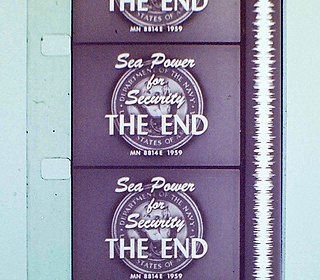
16 mm film is a historically popular and economical gauge of film. 16 mm refers to the width of the film ; other common film gauges include 8 and 35 mm. It is generally used for non-theatrical film-making, or for low-budget motion pictures. It also existed as a popular amateur or home movie-making format for several decades, alongside 8 mm film and later Super 8 film. Eastman Kodak released the first 16 mm "outfit" in 1923, consisting of a camera, projector, tripod, screen and splicer, for US$335. RCA-Victor introduced a 16 mm sound movie projector in 1932, and developed an optical sound-on-film 16 mm camera, released in 1935.

Super 8 mm film is a motion-picture film format released in 1965 by Eastman Kodak as an improvement over the older "Double" or "Regular" 8 mm home movie format.
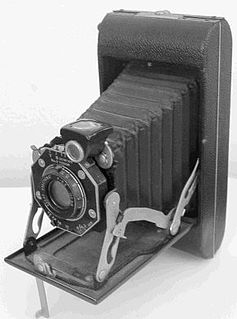
A folding camera is a camera type. Folding cameras fold into a compact and rugged package for storage. The lens and shutter are attached to a lens-board which is connected to the body of the camera by a light-tight folding bellows. When the camera is fully unfolded it provides the correct focus distance from the film. The key advantage of folding cameras is their excellent physical-size to film-size ratio when the camera is folded for storage.

135 film, more popularly referred to as 35 mm film or 35 mm, is a format of photographic film used for still photography. It is a film with a film gauge of 35 mm (1.4 in) loaded into a standardized type of magazine – also referred to as a cassette or cartridge – for use in 135 film cameras. The engineering standard for this film is controlled by ISO 1007 titled '135-size film and magazine'.

120 is a film format for still photography introduced by Kodak for their Brownie No. 2 in 1901. It was originally intended for amateur photography but was later superseded in this role by 135 film. 120 film survives to this day as the only medium format film that is readily available to both professionals and amateur enthusiasts.
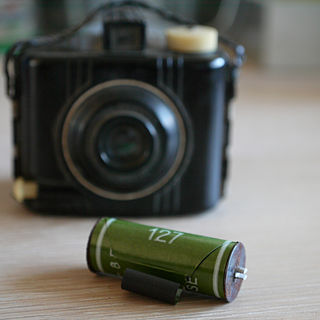
127 is a roll film format for still photography introduced by Kodak in 1912.

126 film is a cartridge-based film format used in still photography. It was introduced by Kodak in 1963, and is associated mainly with low-end point-and-shoot cameras, particularly Kodak's own Instamatic series of cameras.
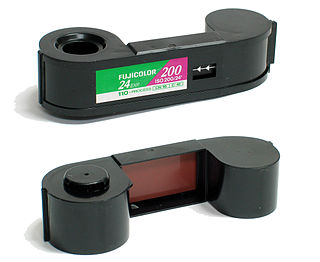
110 is a cartridge-based film format used in still photography. It was introduced by Kodak in 1972. 110 is essentially a miniaturized version of Kodak's earlier 126 film format. Each frame is 13 mm × 17 mm, with one registration hole. Cartridges with 12, 20, or 24 frames are available on-line. Production variations sometimes have allowed for an additional image.
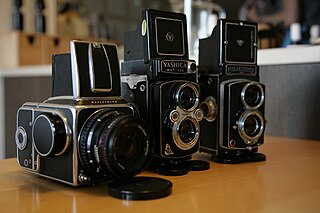
Medium format has traditionally referred to a film format in photography and the related cameras and equipment that use film. Nowadays, the term applies to film and digital cameras that record images on media larger than the 24 mm × 36 mm used in 35 mm photography, but smaller than 4 in × 5 in.
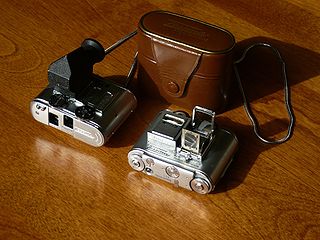
Subminiature photography is photographic technologies and techniques working with film material smaller in size than 35mm film, such as 16mm, 9.5mm, 17mm, or 17.5mm films. It is distinct from photomicrography, photographing microscopic subjects with a camera which is not particularly small.

In photography, reversal film or slide film is a type of photographic film that produces a positive image on a transparent base. Instead of negatives and prints, reversal film is processed to produce transparencies or diapositives. Reversal film is produced in various sizes, from 35 mm to roll film to 8×10 inch sheet film.

Large format refers to any imaging format of 9 cm × 12 cm or larger. Large format is larger than "medium format", the 6 cm × 6 cm or 6 cm × 9 cm size of Hasselblad, Mamiya, Rollei, Kowa, and Pentax cameras, and much larger than the 24 mm × 36 mm frame of 35 mm format.

Instant film is a type of photographic film that was introduced by Polaroid Corporation to produce a visible image within minutes or seconds of the photograph's exposure. The film contains the chemicals needed for developing and fixing the photograph, and the camera exposes and initiates the developing process after a photo has been taken.

Ektachrome is a brand name owned by Kodak for a range of transparency, still, and motion picture films previously available in many formats, including 35 mm and sheet sizes to 11 × 14 inch size. Ektachrome has a distinctive look that became familiar to many readers of National Geographic, which used it extensively for color photographs for decades in settings where Kodachrome was too slow. In terms of reciprocity characteristics, Ektachrome is stable at shutter speeds between ten seconds and 1/10,000 of a second.
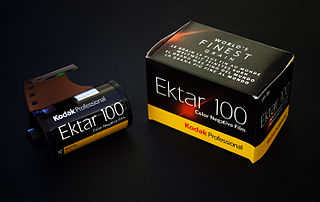
Kodak Ektar is a professional color negative film introduced in 2008, designed for nature, outdoors, fashion, and product photography. The film offers ultra-fine grains, ultra-vivid colors, and high saturation, and is available in ISO 100 only.

828 is a film format for still photography. Kodak introduced it in 1935, only a year after 135 film. 828 film was introduced with the Kodak Bantam, a consumer-level camera.

Standard 8 mm film, also known as Regular 8 mm film, Double 8 mm film, Double Regular 8 mm film, or simply as Standard-8 or Regular-8, is an 8 mm film format originally developed by the Eastman Kodak company and released onto the market in 1932.
















